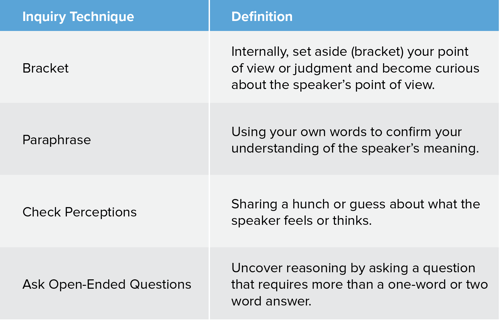IA Insights > Blog
Don’t Be Silent - Have The Conversation
Don’t Be Silent - Have The Conversation
When COVID-19 began creeping into the Boston area, my husband and I took steps that seemed right to protect our family. We pulled our daughter out of school a few days before things shut down in Massachusetts, stocked up on canned goods, minimized grocery store trips, and started staying home as much as possible. Thinking back now, we figured and hoped the outbreak would end soon and we could resume with our normal lives.
Then came the horrific deaths of Ahmaud Arbery, Breonna Taylor, and George Floyd. There had been many senseless deaths of black people in the US in recent years, but because of the pandemic, more people started paying attention, including me, to the broader issue of racial disparity and injustice.
In these moments, it can feel like the entire world is tipping. The COVID-19 pandemic continues to loom over us. The streets and social media are now filled with protesters calling for an end to the racial inequity that black people have faced since first arriving to the US as slaves. For the first time, many white people are noticing and acknowledging their privilege, and beginning to take personal action to confront a system that has oppressed and discriminated against black and other people of color for generations.
When I reflect on the difficulties the world is facing right now, my thoughts can overwhelm me. I know this is true for other people, maybe you too. It becomes easy to lose our direction and begin to feel as lost as the world is right now. And so, how DO we navigate our feelings and communicate with one another in an effective way? Over the last few months, if you’ve found yourself dealing with strong feelings about things like the pandemic or trying to figure out how to become a more authentic ally, much like myself, having a few tools to call upon can be helpful. And while these tools in and of themselves will not automatically solve all the world’s current issues, they will help you work better together and communicate along the way.
The Big Picture
For a long time, I thought that I was an ally to the black community. I listened, I saw, I validated their feelings. But recently, I’ve come to understand that what I was doing only scratched the surface and if I want to authentically be an ally, there is much more work for me to do. To help me tackle this work, I’ll need a plan – specifically a change plan. That’s where The Big Picture comes in. Using this tool from Interaction Associates helps to create that plan by breaking it into three easy steps: Where am I now? Where do I want to be? How will I get there? When I use this tool, I like to start by thinking about the future – Where do I want to be? Once I have a vision for that in my mind, I’m able to think critically about Where am I now, which shows me the gap between my current state and desired future state. Then, it’s all about the implementation plan. How will I get there?

Sometimes the road between current and future is as easy as: I’m scared of COVID-19 > I don’t want to catch COVID-19 > I’m going to self-isolate as much as possible. Other times, the situation will be more complicated, and you’ll need to take many different steps to get from current state to desired future state. This is particularly true on a journey towards equity and anti-racism.
Inquiry Techniques
My colleague Michael Reidy recently wrote a blog about being “altered by what is said.” Right now, though, everyone has an opinion about viruses, vaccines, bias, and privilege. Without a strategy to help us listen effectively, we’ll never actually hear one another. The next time you and a family member, friend, or colleague have a differing point of view, try a few of these techniques:

Feedback
In the coming months, as we continue to have these necessary conversations situations are bound to happen that will make us uncomfortable and even angry. With feelings running high, having the ability to both give – and receive – feedback in a constructive way is essential.
Remember these steps when giving feedback:
1. Describe the behavior: For someone to be willing to consider any requests you may make, it’s important that they are clear about what prompted the feedback.
| “Lauren, you told me when you stopped by last week that you wore a mask in the house. I just found out that wasn’t the case.” | “Thomas, when Bree and I were discussing the Black Lives Matter movement yesterday, you commented that All Lives Matter.” |
2. State the impact of the behavior: Being explicit about how you were affected allows the receiver to better understand the consequences of their behavior.
| "Because you didn't wear a mask and have been going to work since COVID-19 began, you've potentially exposed our household." | "That comment is counter-productive to our efforts to move towards racial equity, and it invalidates the experiences of the black community. |
3. Make a suggestion or request: If appropriate, make a suggestion or request of the person to do something about the behavior. Keep in mind though, feedback is not always a mandate for action. Sometimes all you can ask or hope for is understanding.
| "Next time you come by, you'll need to be sure you are wearing a mask." | "I have some resources to read that might be helpful to you, and I would appreciate it if you would keep an open mind and look at them." |
If you find yourself on the receiving end of this feedback, there are also steps you can take to be sure the information you are receiving is truly heard and understood:
1. Summarize your understanding of the feedback: By repeating the speaker's main concerns, you can confirm your understanding as well as convey that you've heard their point of view. Keep in mind, this doesn’t mean you necessarily agree. It's simply a step for building understanding.
| Lauren: "Last week, I told you I would wear a mask when I came by and I didn't. Because of that, I may have potentially exposed you to COVID-10 and you'd like me to be sure to wear a mask in the future." | Thomas: "Yesterday, I made the comment that All Lives Matter, and you let me know you find it counterproductive to the Black Lives Matter movement, and you'd like to share more information with me about the movement." |
2. Ask questions for clarification: If you need more information in order to understand or to respond, use your inquiry techniques.
| Lauren: “Can you be more specific about where I need to wear the mask? Is it only in the house, or would you prefer I wear it when we are outside in the yard, too?” | Thomas: “Could you share with me why Black Lives Matter is so important to you?” |
3. Respond to the suggestion or request: If the feedback comes with a suggestion, simply acknowledge the suggestion. If the feedback comes with a request, you have at least four choices:
- Accept the request
- Decline the request
- Make a counteroffer or amendment
- Simply express understanding
| Lauren: "Thanks for the clarification and the feedback. Next time I come over I'll be sure to wear a mask both in the house and in the yard. I apologize I didn't do that last time." | Thomas: "I'm willing to look at things from a different point of view and would appreciate those resources. Thanks for sharing your feedback with me." |
In summary, there’s a lot going on right now. The world is in the midst of a far-reaching and ongoing shift, and emotions are high. Be kind to yourself and others. Let these tools help you make a plan, ask questions that alter your thinking and perception of the world, and provide and receive feedback that is constructive, productive, and meaningful. We ARE better, together.
About Kaitlyn Labbe
Kaitlyn’s mission is to generate interest in Interaction Associates by qualifying new opportunities and developing relationships with future customers. A native of Massachusetts and 15-year veteran in the client services industry, Kaitlyn also has experience as a Concierge, Travel Destination Expert and Agent, and Events Manager.





